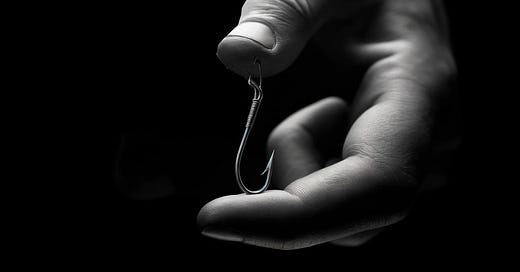What’s the most important sentence of your article?
Not paragraph, not section. The most important sentence.
Early in my writing career, I thought all sentences were equal. Many writers make this mistake, treating this crucial piece as nothing more than the “start.”
But this is wrong. The first sentence, also called the hook, is easily the most crucial piece in the body of your writing.
Imagine the headline as the shiny lure that captures the reader’s attention. The first sentence — the hook — is what pulls them in. That’s the reason for the name. It’s meant to “hook” the reader into the rest of your article, like how you would pull a fish out of water after it’s caught a lure.
But why is this the case? And how can you make a good hook? By the end of this edition, you’ll know everything about it. Read on.
Fact: Your Readers Want to Spend as Little Time Reading as Possible
Your audience don’t owe you anything. They want to get on with their lives. They don’t want to spend it reading. They want to learn, be entertained, be inspired.
The first few lines of the article is usually enough to tell them that.
Seems unfair? Remember, your readers are giving you a small portion of their lives.
Sounds more serious, doesn’t it? Nobody wants to give their life away for nothing. They want to make sure that every second counts. Thus, the main purpose of the hook is to tell readers one thing:
“Yes, it’s worth it. You’re going to get what you came here for, and more.”
Without a good hook, your words will go unread, no matter how brilliant. Your readers will just go, “Eh, not worth my time.”
The task here then is to ensure that your hook does three things very well:
Promises a big pay-off once they finish reading
Builds momentum
Sets the tone
If you can accomplish these three things, you will tell a reader everything below is worth reading.
Here’s How to Write a Compelling First Line
The secret lies in creating curiosity.
Here are several ways to achieve that.
1. Arouse Strong Emotions
People are drawn to writing that makes them feel something; excitement, anger, nostalgia, or curiosity. Start with a statement that hits the emotional core of your topic.
Example (from this article.)
“I have a problem with using AI to “make” ideas.”
This worked because it provoked frustration and curiosity, perfect hooks for luring interested readers.
2. State Incomplete Ideas
Humans are wired to seek closure. When you present a deliberately unfinished idea, readers will naturally want to know the rest.
Example (from this article.)
“There’s a growing problem in the writing industry.”
The mystery here compels readers to find out what the problem is.
3. Ask Questions
Questions engage readers directly, making them reflect or search for answers in your text.
Example (from THIS article)
“What’s the most important sentence of your article?”
This hook directly asked you a question. It engaged your brain and naturally made you seek an answer, which is why you’re still reading.
4. Stir Intrigue
Create an unusual or unexpected scenario, drawing readers into your narrative.
Example (from this article)
“Some months ago, I lost my job.”
This sets up a story that feels too good to skip.
Momentum That Keeps Readers Engaged
When your hook works, readers don’t stop after the first line. They want to know what’s next. This builds momentum, carrying them through to the end of your piece.
A well-crafted hook makes your readers forget they even had the choice to stop reading. That’s the power of a great opening.
That’s all for this email. What did you think?





Thank you for sharing!🧠